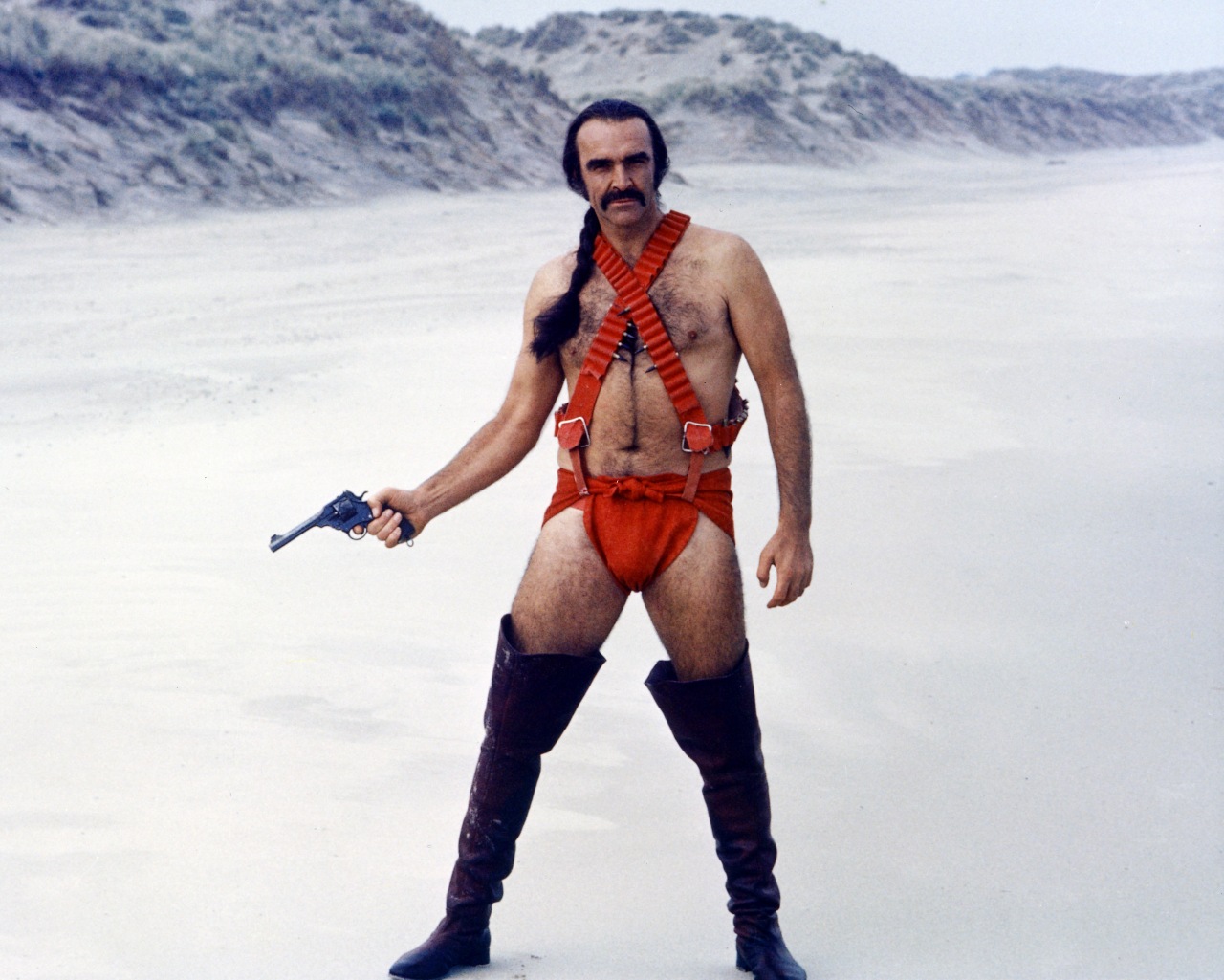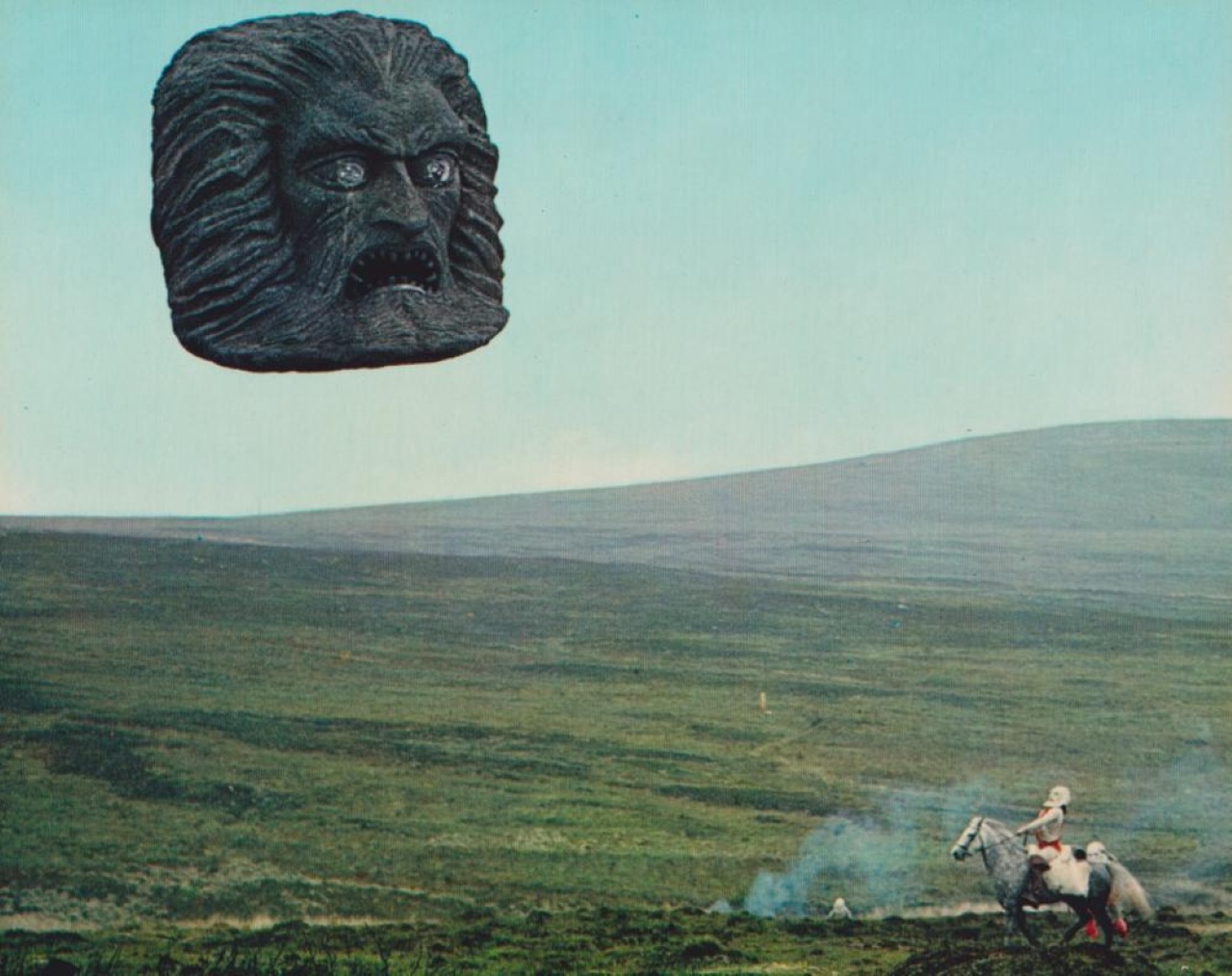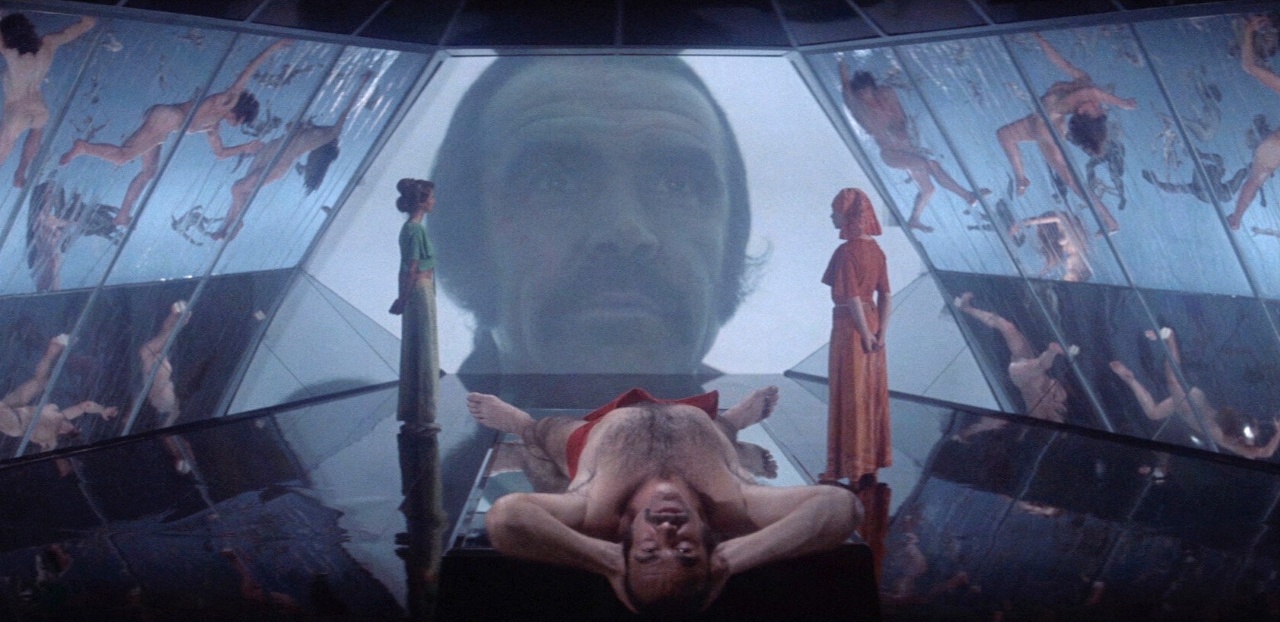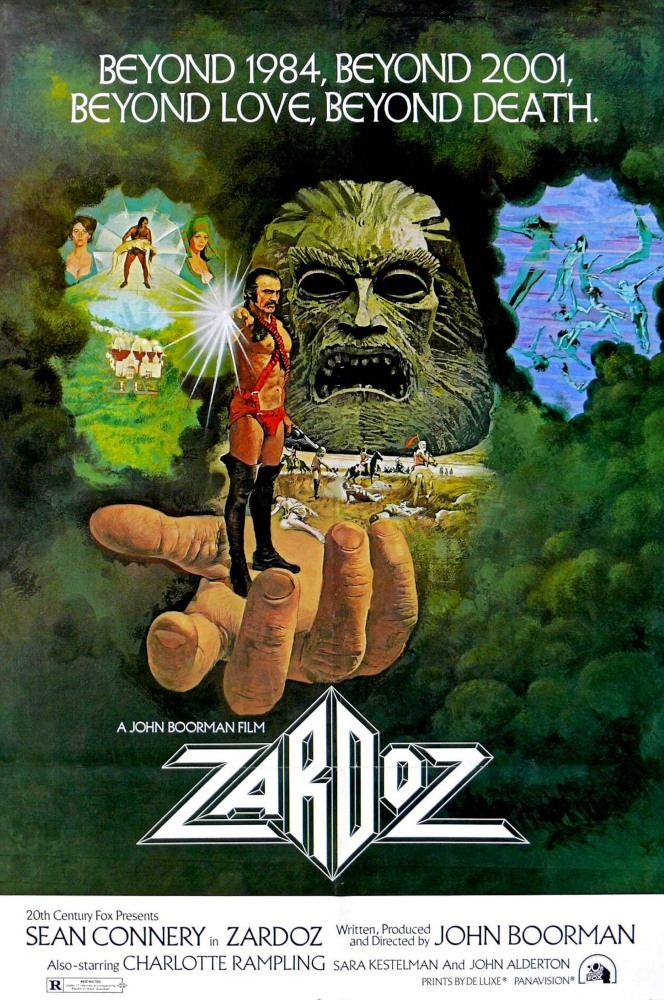Crew
Director/Screenplay/Producer – John Boorman, Cinematography – Geoffrey Unsworth, Music – David Munrow, Process Projection Effects – Charles Staffell, Special Effects – Gerry Johnston, Makeup – Basil Newall, Production Design – Anthony Pratt. Production Company – John Boorman Productions.
Cast
Sean Connery (Zed), Charlotte Rampling (Consuella), Sara Kestelman (May), John Alderton (Friend), Sally Ann Newton (Avalow), Niall Buggy (Arthur Frayn)
Plot
It is the year 2293. Humanity is divided into two groups. There are The Immortals who have banished death and live an idyllic life of leisure and intellectual pursuit in The Vortex behind a forcefield, while outside in the wastelands live the barbarian Brutals. One of the Immortals, Arthur Frayn, has created a religion in which a Brutal elite known as The Exterminators worships the flying godhead Zardoz. From Zardoz’s mouth, Arthur provides The Exterminators with guns so they can annihilate the rest of the Brutals. One of the Exterminators, Zed, sneaks aboard Zardoz and is transported back through the Vortex. Captured, Zed’s primitive aggression and sexuality becomes an object of both great fascination and fear to the bored Immortals. Zed determines to discover the truth of The Vortex, which has been blanked from the Immortals’ minds. In so doing, it becomes apparent that he carries with him the seed that can destroy their idyllic world and bring the return of death to The Vortex after many centuries.
In the early 1970s, British director John Boorman was regarded as a major new and rising talent. After making his directorial debut in 1963, Boorman made acclaimed works like the gangster film Point Blank (1967), the war film Hell in the Pacific (1968) and the strange Leo the Last (1970). Around this period, he also attempted (but failed) to get an adaptation of The Lord of the Rings off the ground. Boorman then made the grim Backwoods Brutality film Deliverance (1972), which was a massive hit that was nominated for an Academy Award for Best Picture and Boorman for Best Director.
The success of Deliverance gave John Boorman the artistic freedom to make fairly much whatever he wanted – he only pitched the studios a film synopsis and withheld the final script, while asking full creative control over the film. Most of them turned him down but 20th Century Fox greenlit the film. Without that success behind him, Zardoz would almost certainly never have been greenlit by a studio. Boorman even had enough collateral to be able to cast Sean Connery who had finally said never again and quit the James Bond series and was considered the highest paid star in the world at the time.
I like almost all of John Boorman’s films but he is a director capable of swinging between great extremes. There are times he makes films with a visionary brilliance – Deliverance, Excalibur (1981) or the solid drama of latter-day works like The General (1998) and The Tailor of Panama (2001). At other times, Boorman is capable of drowning in the most godawful pretensions – the most notable example being the incoherent muddle of Exorcist II: The Heretic (1977), which is regarded as one of the worst sequels ever made. Excalibur nearly goes that way at times but is saved by Boorman’s rapturous pageantry and imagery. The most notorious example of unchecked pretensions in John Boorman’s oeuvre however is Zardoz.

Clearly, in giving Boorman the finance to make Zardoz (a then sizeable $7 million budget), 20th Century Fox were attempting to jump aboard the bandwagon created by Stanley Kubrick’s 2001: A Space Odyssey (1968). 2001 created a new vision for science-fiction – one that moved away from the fear-ridden 1950s, embraced the dawn of the Space Age and went beyond that to create a vision of transcendental space. Kubrick sought to explore places of the mind and posited gigantic ideas about the evolution of the human species. Unfortunately, what most films that attempted to copy 2001 latched onto was either its psychedelic visions, which throughout the 1970s usually became a shorthand to represent an acid-inspired expansion of the mind, or the image of a sterile future where humanity was being quashed by its machinery and drowning in an antiseptic sterility.
Normally in criticizing science-fiction cinema, the most common problem that films suffer from is a lack of imagination or of failing to worthily explore the ideas they have. Here the problem is exactly the opposite. The one thing that Zardoz is certainly not short of is ideas – in fact, it frequently collapses under the strain of John Boorman reaching for philosophical profundities to the point of pretension.
The opening sets the scene with Niall Buggy appearing as a talking head to address the audience: “In this tale, I am a fake god by occupation … I am the puppet master. I manipulate many of the characters and events you will see. But I am invented too for your entertainment – and amusement.” He then turns to refer to the audience direct: “And you, poor creatures, who conjured you out of the clay? Is God in show business too?” Moments later, we get the flying godhead Zardoz proclaiming such pretentious profundities as: “The gun is good and purifies the Earth, the penis is bad,” before we are introduced to Sean Connery in his orange jockstrap and mask as he picks up one of the guns, turns and shoots directly into the camera.
Watch other ludicrous scenes like the dinner-party where people condemn John Alderton by waggling their extended hands at him whereupon he starts rolling around making aghast cries of moral-philosophical anguish before turning into an old person and being banished to what looks like a psychiatric hospital filled with others who are prematurely aged. Or the scenes with Sean Connery running around the psychedelic maze, fighting reflections of himself and muttering philosophical doubletalk.

The idea of Sean Connery cast as an avatar of male sexuality come to save the future contains a certain giggliness – in one hilarious scene, John Boorman even has Connery outfitted in a wedding dress. The end with Sean Connery and Charlotte Rampling sitting, staring at the camera, holding hands and lap-dissolving into old age, raising a strapping barbarian son who sits for a while aging with them, before they finally dissolve into skeletons still holding hands, is the final hilariously melodramatic icing on the cake of the film’s pretensions.
The title involves a silly play on The Wizard of Oz (1939) – it being a concatenation of [wi]Zard [of] Oz whereupon much metaphor is spun between the fake flying godhead and the Wizard of Oz being a giant head that a charlatan created to make the populace fear him. One would think that amid Boorman’s philosophical claptrap he could find a more interesting idea than a stale reworking of the old cliche that immortality produces sterility or that scientific presumption is an affront against Nature.
There is no denying that John Boorman has created a fascinatingly complex future world but quite what is going on or he is trying to say is beyond easy understanding. Zardoz‘s plot arc is essentially a similar one to George Romero’s Land of the Dead (2005) – where an elite have created a hermetic utopia for themselves and left the underprivileged to fend for themselves beyond its walls. Here however, Boorman posits that the Flower Children of the 1960s have become the new elite, creating a world based on pastel coloured kaftans, meditation, psychedelics and transcendental headspace, and a communal society where all are equal and harmonize with nature. This must have seen an irresistible ideal in the middle of the love generation. The problem with this is that the Immortals are also seen as sterile and in need of rediscovery of love, whereas in actuality the hippies never had any problem discovering love and it was the values of their parents that they regarded as sterile.

One can make parallels to Logan’s Run (1976), which came out a couple of year later and had a similar plot about a self-enclosed Utopia where everybody lived in perpetual pleasure in pretty multi-coloured kaftans. While both stories are at opposite extremes, both films are about a society that idolizes perpetual youth and pleasure and the banishment of old age. Both films also see that what is needed is a puncturing of the bubble of this Free Love Generation utopia and the rediscovery of the real world, flawed and all as it might be. The motivating factor behind social action at the centre of both stories is the love between a man and a woman.
Certainly, there are pluses to Zardoz. One of these is the exquisitely beautiful location shooting in Ireland, which offers some stunning vistas of verdant greenery. (The farm locations where Zardoz first lands were apparently shot at John Boorman’s own home in County Wicklow). There are also some excellent sets – like the room where Sean Connery is mind probed, which is shaped like a trapezoid crystal with walls that appear to contain naked bodies frozen inside in strange positions. The running about the crystal and mind games in the middle of the film entertains on a purely trippy level with Boorman offering up some beautiful psychedelic light shows.
The cast are generally capable despite the silliness of the lines they are asked to say. Sean Connery does a remarkable job in playing everything in straight face. Sara Kestelman tends to the watery in personality but standout is Charlotte Rampling, a grand dame of the English acting profession in recent years, here at her youngest and most beautiful. As always, Rampling is an actress who plays with a glacial acidity as though ice water runs through her veins.
John Boorman’s other genre films:– the Backwoods Brutality film Deliverance (1972); Excalibur (1981); Exorcist II: The Heretic (1977); the Amazonian rainforest drama The Emerald Forest (1985), which has Magical Realist elements; and the doppelganger film The Tiger’s Tail (2006). Boorman also produced the children’ film Dream One (1984). In more recent years, John Boorman has interestingly announced plans for conducting an animated version of The Wonderful Wizard of Oz.


